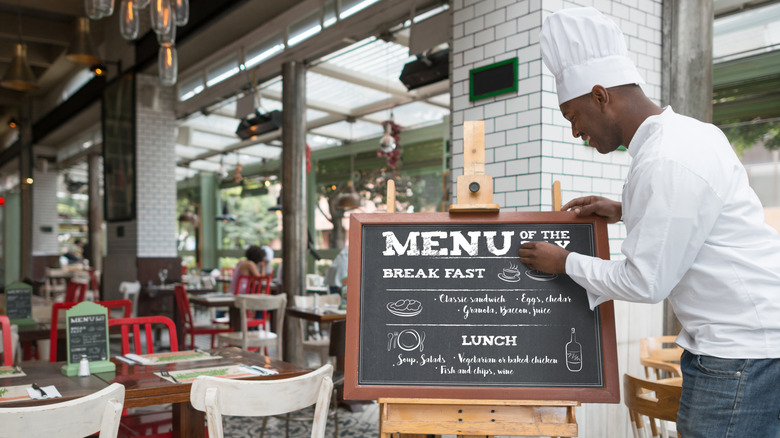The Hidden Costs That Are Factored Into Restaurant Menu Prices
If you've noticed menu prices have become quite expensive, you're not the only one. In addition to battling record inflation and high costs on kitchen staples like eggs, restaurants also have to pay several regular hidden costs that, ultimately, are reflected in their menu prices. These generally include labor costs, food costs, energy and utility costs, and rent.
Take, for example, the Rivington bagel, a menu item at Rose Foods in Portland, Maine recently highlighted in a Bon Appétit article. The bagel topped with smoked sable costs a customer $20, but Rose Foods barely makes any profit off it, as $8.70 of that $20 goes toward food costs for the item — quality sable costs $40 per pound and skimping on quality is not an option for this establishment — and $10 goes toward labor costs for the eatery. Owner Chad Conley says labor is his biggest expense at the shop, with the kitchen staff starting at $18 per hour and front of the house staff at $8 before tips are factored in. "It's the restaurant's largest expense category by far, so it has a huge impact on our menu prices," Conley said.
Keeping the lights on also costs money
Per Restaurant Business, prices on fast food restaurant menus have also gone up due to increased labor costs. Large chains, such as Chipotle, have to pay their employees more money, and typically end up passing that cost on to the consumer. The same thing is going on at full-service restaurants, where menu prices went up 4.1% in May of 2021. Chron says fast-food eateries generally pay 25% of their sales in labor costs, while sit-down restaurants pay somewhere between 30% and 40%.
But it's not just food and labor that factor into the hidden costs of restaurant menu prices. Energy and utility costs for the restaurant also play a role in the price you're paying for your meal, and, according to Chef José Avillez, a restaurateur in Portugal, these costs have increased as well. "In one year, we noticed that our energy costs have doubled. There was a 100% increase in our expenses in this regard, it's absurd," Avillez told Fine Dining Lovers in March 2022.
Back at Rose Foods in Maine, Chad Conley tells Bon Appetit that rent — which runs the business about $4,000 each month — also has to be taken into consideration when deciding on menu prices. Therefore, restaurants don't just set their prices willy nilly. Costs for labor, food, energy, and rent are factored into the equation, and the cost is inevitably passed on to the consumer in some capacity.

